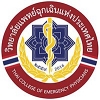Emergency department visited for elderly patients in Bangkok, Thailand before and after severe flooding in 2011
Keywords:
disaster, elderly, Thailand’s floodAbstract
Introduction: Thailand's major flood since 2011, causing widespread impact in Bangkok and nearby provinces, which affects the mind and the human body and over time could cause a patient to the emergency department (ED) more than usual, the elderly is weak and needs help.
Objective: This study aims to compare the prevalence of diseases; characteristics that lead older adults visited the ED, in the period before flood (BF) and after the flood (AF) in Bangkok 2011.
Methods: This study was a retrospective chart review. Data were proceeding from electronic medical records (EMRs) in the period BF in Augusts 5, 2011 to October 4, 2011 and AF in October 5, 2011 to November 25, 2011. All patients age 60 years and over who came to the ED were enrolled. Data were compared between BF and AF included characteristics, diagnosesand adverse outcomes which defined as ED revisits, prolong hospitalization (>7 days)
Results: Our study had 388 patients in BF group and 401 patients in AF group. Most of them were female in both groups [BF group 230(59.3%) versus (vs.) AF group 235(59.6%)]. In AF group had more patients in age group 60-74 years than BF group [AF 275(68.6%) vs BF 173(44.6%) p<0.01]. In AF group had ED visited time at 16.01-0.00 more than BF group [AF 175(43.6%) vs. BF 141(36.3%) p=0.04]. Most common chief complaint was dyspnea [AF 73(18.2%) vs. BF 56(14.4%) p=0.15]. In AF group complaint more for “muscle pain” than BF group [AF 11(2.7%) vs. BF 7(1.8%)]. There was no difference of adverse outcomes between groups.
Conclusion: After flood in Thailand, ED had more young older age group visited, came in the afternoon and had more complaint for muscle pain compared with BF. Prepares to medical personnel when older people come to the ED if disaster to next time.
References
กรมป้องกันและบรรเทาสาธารณภัยกระทรวงมหาดไทย [Internet][Cited 2016 Jan 6] Availlable from: http://122.155.1.145/cmsdetail.KM-2.182/3498/menu_3389/1433.1/4ความรู้เรื่องภัยพิบัติ
Morin VM, Ahmad MM, WarnitchaiP.Vulnerabilityto typhoon harzards in the coastal informal settlements of Metro Manila, the Philippines. Disaster2016. https://doi.org/10.1111/disa.12174.
Ishiki A, Okinaga S, Tomita N, Kawahara R, Tsuji I, Nagatomi R, et al. Changes incognitive functions in the elderly living in temporary housing after the Great East Japan earthquake.PLoS One [Internet]. 2016 Jan [cited 2016 May 14];11(1):e 014025. Available from http://journals.plos.org/plosone/article?id=10.1371/journal.pone.0147025
Yoshimura E, Ishikawa-Takata K, Murakami H, Tsuboyama-Kasaoka N, Tsubota-Utsugi M, Miyachi M, et al. Relationshipsbetween social factors and physical activity among elderly survivors of the Great East Japan earthquake: a cross-sectional study. BMC Geriatr [Internet]. BMC Geriatrics; 2016; 16(1):30. Available from: http://www.biomedcentral.com/1471-2318/16/30
Doran KM, McCormack RP, Johns EL, Carr BG, Smith SW, Goldfrank LR, et al. Emergency department visits for homelessness or inadequate housing in New York City before and after hurricane Sandy. J Urban Heal [Internet].2016;93(2):331–44. Available from: http://link.springer.com/10.1007/s11524-016-0035-z
Lee DC, Smith SW, Caw BG, et al.Geographic distribution of disasterspecific emergency department use after hurricane sandy in New York city. Disaster Med Public Health Prep. 2016 https://doi.org/10.1017/dmp.2015.190.
Gotanda H, Fogel J, Husk G, Levine JM, Peterson M, Baumlin K, et al. Hurricane Sandy: Impact on emergency department and hospital utilization by older adults in lower Manhattan, New York (USA). Prehosp Disaster Med. 2015;30(5):496-502.
สถานการณ์ผู้สูงอายุไทย พ.ศ. 2556 [Internet][Cited 2016 Jan 6] Availlable from: http://www.thaitgri.org/
Guerena-Burgueno F, Jongsakul K, Smith BL, Ittiverakul M, Chiravaratanond O. Rapid assessment of health needs and medical response after the tsunami inThailand,2004- 2005. Mil Med 2006; 171(supple 1):8-11.
การดูแลผู้สูงอายุติดบ้านติดเตียง [Internet][Cited 2016 Jan 6] Available from: http://www.thaiHealth.or.th/Content/35697-การดูแลผู้สูงอายุติดบ้านติดเตียง.html
Sihawong R, Janwantanakul P, Pensri P. Incidence of and risk factors for Musculoskeletal symptoms in the neck and low-back during severe flooding in Bangkok in 2011. J Rehabil Med. 2012 Jul; 44(8):624–8.
Wade TJ, Lin CJ, Jagai JS, Hilborn ED. Flooding and emergency room visits for gastrointestinal illness in Massachusetts: A case-crossoverstudy. PLoS One. 2014; 9(10):1–9.
Ding G, Zhang Y, Gao L, Ma W, Li X, Liu J, et al. Quantitative analysis of burden of infectious diarrhea associated with floods in Northwestof Anhui Province, China: A Mixed Method Evaluation.PLoS One.2013;8(6):1–9.
Ivers LC, Ryan ET. Infectious diseases of severe weather-related and flood-related natural disasters. Curr Opin Infect Dis. 2006 Oct;19(5):408–14.
Downloads
Published
How to Cite
Issue
Section
License
บทความที่ได้รับตีพิมพ์ในวารสารเวชศาสตร์ฉุกเฉินแห่งประเทศไทย ถือเป็นเป็นลิขสิทธิ์ของ วิทยาลัยแพทย์เวชศาสตร์ฉุกเฉินแห่งประเทศไทย
กรณีที่บทความได้รับการตีพิมพ์ในวารสารเวชศาสตร์ฉุกเฉินแห่งประเทศไทยแล้ว จะตีพิมพ์ในรูปแบบอิเล็กทรอนิกส์ ไม่มีสำเนาการพิมพ์ภายหลังหนังสือเผยแพร่เรียบร้อยแล้ว ผู้นิพนธ์ไม่สามารถนำบทความดังกล่าวไปนำเสนอหรือตีพิมพ์ในรูปแบบใดๆ ที่อื่นได้ หากมิได้รับคำอนุญาตจากวารสารเวชศาสตร์ฉุกเฉินแห่งประเทศไทย




